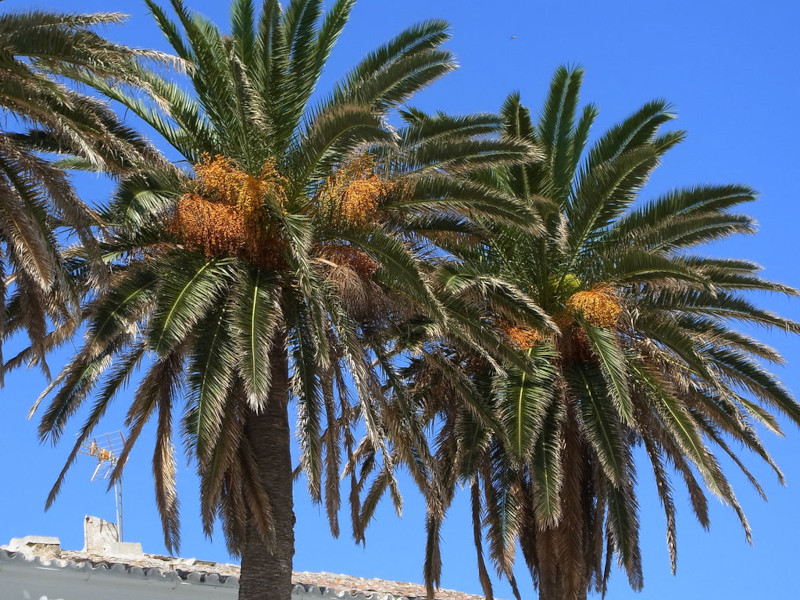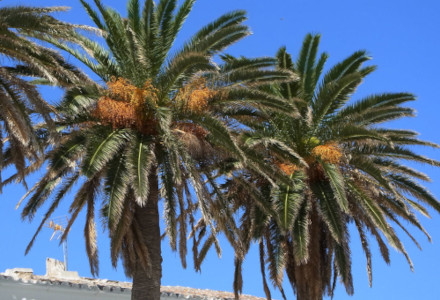
Canary Island Date Palm Facts
- This product of evolution and Nature most frequently goes by the informative common name of the Canary Island Date Palm. It also has another general name, though. That’s because it’s also known by the shorter term of the pineapple palm.
- Among professionals, such as researchers, however, it’s generally better known by its official title. That moniker, though, as often occurs, is somewhat hard for the layperson to pronounce. That’s due to it having the formal name of Phoenix canariensis.
- The tree received that name due to the work of the respected French botanist, Jutin-Benjamin Chabaud. He made the first formal acknowledgement of it as a separate and distinct species. This noteworthy action occurred in the late 19th century.
- It’s also been widely dispersed due to its popularity as an ornamental plant. This has, however, led to its being considered an invasive species in parts of the world. It’s now naturalized in areas outside its native range, including Bermuda and the United States.
- It further appears to be maintaining a population base that’s both stable and sufficient. This also seems to hold true throughout the entirety of its native range. The IUCN, therefore, presently has no listing for it on the organization’s published Red List.
- The impressive Canary Island Date Palm nevertheless does face some potential threats to its existence. Habitat loss could, at least in its natural range, eventually pose a danger. Its greatest threat, however, likely consists of ongoing climate change.
Related Articles
Canary Island Date Palm Physical Description
The Canary Island Date Palm ranks as one of those plants that impresses those who encounter it. In its case, though, it does so for a variety of reasons. While simple physical size isn’t its only, or even greatest, appeal, it nonetheless remains worthy of mentioning.
Fully mature specimens attain average heights measuring about 66 ft (20 m). Exceptional individuals do occur, however. These rare examples sometimes reach heights of as much as 131 ft )40 m)! That makes this species a truly remarkable member of its specific Order.
The trunk also boasts impressive attributes. This part of the flora often achieves diameters of up to 3 ft (90 cm). This relatively thick, columnar-shaped structure typically presents as a grayish-brown in mature specimens. The trunk boasts diamond-shaped leaf bases.
The foliage of this amazing work of Nature develops on both sides of a long, thin stem. These also crreate a remarkable image themselves. That’s due to the fact that they average 13 – 20 ft (4 – 6 m) in length! Between 80 -100 leaflets appear on each side of the stem.
The flowers produced by the Canary Island Date Palm serve as yet another intriguing aspect of the tree. It produces these in large quantities. Each develops a beautiful creamy-yellow shade. So many develop, though, that they hang in panicles up to 4 ft (120 cm) in length.
Its fruit adds yet another noteworthy feature to its list of appealing characteristics. These appear with a reddish yellow color, and a shape reminiscent of dates. These fruties typically measure approximately 1 in (2.5 cm) in length. Its typical width equals around 0.4 in (1 cm).
- Kingdom: Plantae
- Phylum: Spermatophyta
- Class: Monocotyledonae
- Order: Arecales
- Family: Arecaceae
- Genus: Phoenix
- Species: P. canariensis
Canary Island Date Palm Distribution, Habitat, and Ecology
The fabulous Canary Island Date Palm evolved as native to a region of the globe well known for its abundance of natural wonders. That’s due to the fact that this wondrous marvel of Nature and evolution evolved as endemic to a beautiful region of the Atlantic Ocean.
More specifically, as the name itself implies, the tree developed in the Canary Islands. This archipelago, itself an extraordinarily beautiful region, lies within the greater area known as Macaronesia. The continent of Africa remains the closest major land mass to the islands.
Given its native range, this intriguing Angiosperm developed certain habitat requirements. Somewhat surprisingly, though, it’s also comparatively adaptible. In its native environment, it lives in regions of warmer temperatures, rich soils, and copious humidity.
Yet it also displays a surprising flexibility that amazes many people. Despite its development in a Mediterranean-type climate, it also flourishes, in cultivation, in sub-tropical climates. This includes such regions as the southeastern United States, and eastern Australia.
The gorgeous Canary Island Date Palm plays an important natural role in its native ecosystem. Its fruit nourishes a wide range of indigenous species. To the further suprise of many who learn of it, the principal pollinator of the species appears to be the weevil.
Propagation of the tree occurs exclusively due to spreading of the copious seeds produced. This happens due to a variety of causes. Simple dropping of the seeds by overripe fruit obviously makes the list. It also manages this via the droppings of birds that eat the fruit.
Species Sharing Its Range
Check out our other articles on Texas Blind Salamander, Northern Flying Squirrel, Macquarie Island, Peacock Butterfly, Lau Banded Iguana, European Honey Buzzard

